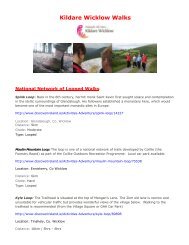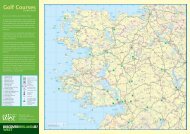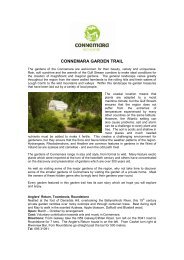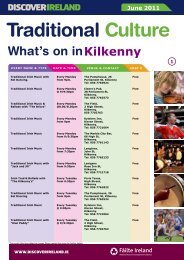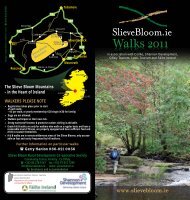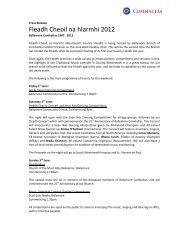Free Guide - Discover Ireland
Free Guide - Discover Ireland
Free Guide - Discover Ireland
Create successful ePaper yourself
Turn your PDF publications into a flip-book with our unique Google optimized e-Paper software.
Passage tombs consist of a burial chamber<br />
reached by a long straight passage lined<br />
with stones, and set within a large mound<br />
known as a cairn. They are usually sited<br />
on hilltops and grouped in cemeteries.<br />
Although primarily burial sites, they also<br />
served as status symbols, focal points for<br />
the community, places to honour dead<br />
ancestors and as territorial markers.<br />
It is estimated that there are 700 decorated<br />
stones at Brú na Bóinne making it Europe’s<br />
largest and most important concentration<br />
of prehistoric megalithic art. The most<br />
famous of these stones is the one marking<br />
the entrance to Newgrange where the triple<br />
spiral, unique to this site, can be seen.<br />
Constructed during the New Stone Age (or<br />
Neolithic Period, from Greek “neo” meaning<br />
new and “lithos” meaning stone) the tombs<br />
at Brú na Bóinne are around 5,000 years old.<br />
Although the people who built these tombs<br />
were primarily farmers they also possessed<br />
expertise in engineering, geology, art and<br />
even astronomy.<br />
At dawn on the morning of the winter<br />
solstice, and for a number of days before<br />
and after, the main chamber at Newgrange<br />
is illuminated by a beam of sunlight for<br />
17 minutes. This alignment is too precise<br />
to have occurred by chance. It is thought<br />
that Newgrange is the oldest surviving<br />
deliberately aligned structure in the world.<br />
Although Newgrange, Knowth and Dowth<br />
were constructed around 3000 BC activity<br />
Brú Na Bóinne (Newgrange)<br />
at the sites continued for many millennia.<br />
Knowth for example, served as a burial site in<br />
the Iron Age, as the royal seat of the King of<br />
Northern Brega in the Early Christian period,<br />
and as an Anglo-Norman Motte in the Early<br />
Medieval Period.<br />
There is no direct access to Newgrange and<br />
Knowth; all admission is through the Brú<br />
na Bóinne Visitor Centre which is located<br />
near the village of Donore. The excellent<br />
exhibitions at the Visitor Centre include a full<br />
scale replica of the chamber at Newgrange.<br />
Visitors are brought from the centre to the<br />
monuments by shuttle bus.<br />
Did you know … Constructed around 3200<br />
BC, Newgrange is 500 years older than the<br />
pyramids of Egypt and 1,000 years older<br />
than Stonehenge in England.<br />
Contact Details:<br />
Brú na Bóinne (Newgrange & Knowth), Donore,<br />
Drogheda, Co. Meath<br />
GPS: 53° 41’ 40.20”, -6° 26’ 46.68”<br />
T: + 353 (0) 41 988 0300<br />
F: + 353 (0) 41 982 3071<br />
E: brunaboinne@opw.ie<br />
W: www.heritageireland.ie<br />
Notes:<br />
Visitor Centre and Newgrange is open all year round.<br />
(excl. 24-27 December). Knowth is open from Easter<br />
to end of October. Last admission to the visitor centre<br />
is 45 minutes before closing time. Last admission<br />
to visit any of the sites is 2 hours before closing time.<br />
Please note this site can be extremely busy during<br />
the summer months – early arrival for booking of the<br />
tours is recommended. See www.heritageireland.ie<br />
for additional information.<br />
FOR OPENING TIMES AND ADMISSION DETAILS PLEASE SEE PULL OUT INSERT AT THE BACK 25



